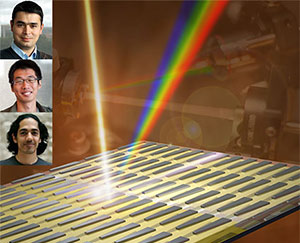Aydin & MNDL Students Research Highlighted in Nature Photonics
Prof. Koray Aydin and his team created visible-frequency metasurfaces for broadband ‘anomalous’ reflection and high-efficiency spectrum splitting.
Prof. Koray Aydin and his team from the Metamaterials and Nanophotonic Devices Lab (MNDL), have created visible-frequency metasurfaces for broadband ‘anomalous’ reflection and high-efficiency spectrum splitting, which has been published in Nano Letters and recently highlighted in Nature Photonics. Nature Photonics is one of the best photonics journals and has very high impact in the academic community.
Conventional optical devices based on the principles of geometrical optics are often bulky and offer limited performance in manipulating light-matter interactions at the wavelength or subwavelength scale due to diffraction limit. Metasurfaces, featured by interfacial subwavelength resonators, could offer new degrees of freedom in moulding the optical wavefronts by introducing abrupt and drastic changes in the amplitude, phase and/or polarization of electromagnetic radiation at the wavelength scale.
EECS PhD students, Zhongyang Li and Edgar Palacios from Aydin’s group have proposed a highly-efficient yet a simple metasurface design comprising of a single, trapezoid silver antenna and demonstrated broadband (450 - 850 nm) anomalous reflection and spectrum splitting at visible and near-IR frequencies with high conversion efficiency. The metasurfaces design could suggest application of achieving flat high signal-to-noise optical spectrometers, polarization beam splitters, directional emitters and spectrum splitting surfaces for photovoltaics.
Excerpted from the research highlight article in Nature Phonics by David Pile, titled Metamaterials: Anomalous reflection
---------------------------------------------------------------------------------------------------------------------------------
When a laser hits a flat surface the beam is usually reflected at an angle equal to the angle of incidence. However, in the case of reflection from a metamaterial, the presence of subwavelength resonators on the surface can impart phase gradients and cause 'anomalous' reflection at other angles. Such effects have been observed in near-infrared or longer wavelength regions but, due to the difficulty of fabricating subwavelength features for visible light operation, demonstrations have been lacking at shorter wavelengths. Zhongyang Li and colleagues at Northwestern University, Illinois, USA, have now demonstrated anomalous reflection of light with wavelengths from 450 to 850 nm. To achieve this they designed a relatively simple system based on an array of nanorods of varying widths, that is, a trapezoid. The 800-nm-long metal resonators vary in width from 30 nm to 150 nm. This is different to many other attempts that used more complicated arrays with parameter gradients across multiple unit cells; here all of the resonators in the array are identical. The efficiency of the anomalous reflection is high and estimated to be approximately 1,000 times stronger than the efficiency of scattering into the first diffraction order. A similar redirection of light into desired angles by 'flat' surfaces can be achieved with structures like blazed gratings but the metasurfaces demonstrated by Li et al. offer broadband operation compared with those concepts that are inherently narrowband. Li et al. note that the idea could lead to high signal-to-noise ratio optical spectrometers, polarization beamsplitters, directional emitters, and spectrum-splitting surfaces for photovoltaics.
